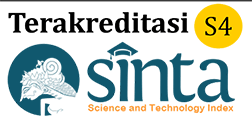Malaria Disease Clustering Analysis Using the K-Means Method in Indonesia
DOI:
https://doi.org/10.32815/jitika.v18i1.991Keywords:
Clustering, Penyakit Malaria, K-Means, Davies-Bouldin Indexs Clustering, Malaria, K-Means, Davies-Bouldin IndexsAbstract
Malaria is a dangerous and potentially deadly disease in Indonesia. The spread and transmission of malaria occurs very rapidly. The aim of this study was to identify clusters within the state based on the intensity of malaria cases. In this study, K-means was applied to the clustering process using the values of K=2, K=3, and K=5. This means that the Davis-Boldan index value for K=2 is 0.033, the Davis-Boldan index value for K=3 is 0.034, and the Davis-Boldan index value for K=5 is 0.262. The research results show that using K-Means with K=2 yields the best cluster with the lowest Davies-Bouldin index value (0.033). This will help the government plan more effective preventive measures in different provinces of Indonesia in the coming years. Therefore, this study makes an important contribution to malaria control efforts to reduce malaria incidence and public health impact in Indonesia.
Downloads
References
[2] Y. Yohannes, S. Devella, and K. Arianto, “Deteksi Penyakit Malaria Menggunakan Convolutional Neural Network Berbasis Saliency,” JUITA J. Inform., vol. 8, no. 1, p. 37, 2020, doi: 10.30595/juita.v8i1.6671.
[3] Karmila, H. S. Tambunan, Sumarno, and A. P. Windarto, “Penerapan Data Mining K-Means dalam Mengelompokkan Kasus Penyakit Malaria Berdasarkan Provinsi dengan Aplikasi RapidMiner,” Reg. Dev. Ind. Heal. Sci. Technol. Art Life, pp. 31–40, 2017, [Online]. Available: https://ptki.ac.id/jurnal/index.php/readystar/article/view/4/pdf (05 Juni 2020).
[4] E. Sari and R. A. Syakurah, “Analisis Manajemen Pelatihan Kader Malaria Pada Populasi Suku Anak Dalam Di Kabupaten Musi Rawas Utara,” J.Abdimas Community Heal., vol. 4, no. 1, pp. 01–08, 2023, doi: 10.30590/jach.v4n1.582.
[5] S. Sindi, W. R. O. Ningse, I. A. Sihombing, F. I. R.H.Zer, and D. Hartama, “Analisis Algoritma K-Medoids Clustering Dalam Pengelompokan Penyebaran Covid-19 Di Indonesia,” J. Teknol. Inf., vol. 4, no. 1, pp. 166–173, 2020, doi: 10.36294/jurti.v4i1.1296.
[6] Y. Bete, D. Santos, R. Lani, A. Ewal, and B. J. Lenggu, “Menentukan Titik Rawan Malaria Di Provinsi Nusa Tenggara Timur Menggunakan Metode K-Means Clustering,” vol. 1, no. 4, 2023.
[7] A. M. Sroyer, S. A. Mandowen, and F. Reba, “Analisis Cluster Penyakit Malaria Provinsi Papua Menggunakan Metode Single Linkage Dan K-Means,” J. Nas. Teknol. dan Sist. Inf., vol. 7, no. 3, pp. 147–154, 2022, doi: 10.25077/teknosi.v7i3.2021.147-154.
[8] A. F. Zohra, S. Anwar, A. Fitri, and M. H. Nasution, “Klasifikasi Wilayah Provinsi Aceh Berdasarkan Tingkat Kerentanan Kasus Malaria Tahun 2015 – 2018,” J. Kesehat. Lingkung. Indones., vol. 18, no. 1, p. 25, 2019, doi: 10.14710/jkli.18.1.25-33.
[9] Y. Nurohmah, R. Mayasari, and B. Nurina Sari, “Optimalisasi Performa K-Means Clustering Dengan Pca Dalam Analisis Tingkat Kemiskinan Di Jawa Barat,” JATI (Jurnal Mhs. Tek. Inform., vol. 7, no. 3, pp. 1657–1665, 2023, doi: 10.36040/jati.v7i3.6884.
[10] R. Ranjawali, A. C. Talakua, and R. T. Abineno, “Clustering Stunting Pada Balita Dengan Metode K- Means Di Puskesmas Kanatang,” SATI Sustain. Agric. Technol. Innov., pp. 80–92, 2023, [Online]. Available: https://ojs.unkriswina.ac.id/index.php/semnas-FST/article/view/587/324.
[11] E. Febrianty, L. Awalina, and W. I. Rahayu, “Optimalisasi Strategi Pemasaran dengan Segmentasi Pelanggan Menggunakan Penerapan K-Means Clustering pada Transaksi Online Retail Optimizing Marketing Strategies with Customer Segmentation Using K-Means Clustering on Online Retail Transactions,” J. Teknol. dan Inf., vol. 13, no. September, pp. 122–137, 2023, doi: 10.34010/jati.v13i2.
Additional Files
Published
How to Cite
Issue
Section
License
Copyright (c) 2024 Suastika Yulia Riska

This work is licensed under a Creative Commons Attribution 4.0 International License.
Upon acceptance for publication, authors transfer copyright of their article to Jurnal Ilmiah Teknologi Informasi Asia. This includes the rights to reproduce, transmit, and translate the material in any form or medium.
While the editorial board endeavors to ensure accuracy, they accept no responsibility for the content of articles or advertisements. Liability rests solely with the respective authors and advertisers.
Website material is licensed under a Creative Commons Attribution 4.0 International License (CC BY 4.0). Under this license, users are free to share and adapt the material for any purpose, including commercial use, provided license terms are met. These freedoms are irrevocable by the licensor under such conditions.














